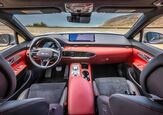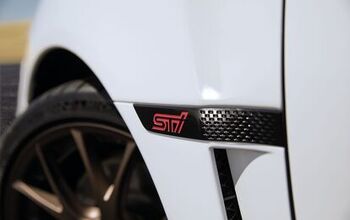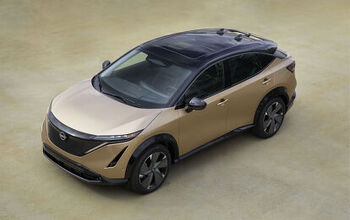2018 Mercedes-Benz GLC 350e 4MATIC PHEV Review

Today’s small crossover segment in which the GLC competes is a murderously competitive and crowded field, filled with offerings from all sides of the automotive spectrum.
Inexpensive, middle-of-the road, sporty – there seems to be no end to the options available. Picking one is like trying to choose your favorite trumpeter in a 100-piece brass band.
Customers do not lack for choice … until one wants to drive solely on electrons. Plug-in hybrids seem to proliferate in the sedan and small car segments. But crossovers? Not so much. The number of plug-in electrified two-box machines on offer to the public can nearly be counted on one hand. Blame consumer tastes, developments costs, or the simple truth of aerodynamics; take your pick.
The GLC 350e is one of two hybrid crossovers in Mercedes showrooms, offered in addition to the big-brother GLE 550e. The company has recently streamlined its naming strategy, making it easy for customers (and your neighbors) to figure out where your new ride fits on the three-pointed star totem pole.
Using the same basic architecture of its traditionally powered GLC 300 brother, the 350e deploys a 2.0L turbocharged inline-four. In the gasoline model, this mill makes 241 horsepower. Here, it is dialed back to 208 horses but benefits from the addition of an 85-kW electric motor. This unit is rated at 114 horsepower and 251 lb-ft of torque but, thanks to different power peaks, one cannot simply add the two horsepower numbers together and arrive at a total output.
In this case, however, it would be a close approximation. The whole system is rated at a not-insignificant 315 horsepower and 413 lb-ft of torque. The 350e is very responsive off the line thanks to the extra grunt, most of which is available near-idle thanks to the power delivery properties of an electrified powertrain. This helps mask its 400-pound weight gain compared to the non-hybrid. Another key difference between the 300 and 350e powertrains is the transmission. The PHEV gives up a pair of gears compared to the gas model, thanks to the nine-speeds alleged inability to handle 413 lb-ft of twist.
Mercedes says the 350e can cover about 20 miles on electricity alone when its 8.7kWh battery is fully charged. It’ll take about 2.5 hours to fully charge the unit using a 240V charger but plan for an overnight jolt of juice if using a standard household wall outlet. It is dead simple to plug in the GLC but your author severely questions the placement of its charging port.
Located on the lower right corner of its rear bumper, any small impact such as a parking lot bump will likely damage the system and result in an expensive repair. I understand why it is there (its proximity to the EV battery will lower production costs) but placing on the GLC’s flank, like most other PHEVs, would be a far more practical solution.
There are a series of operator-selected drive modes tuned to provide maximum efficiency … or maximum grunt, depending on how much of a Hot Rod you’re feeling at any particular moment.
The GLC 350e can be left in its default Hybrid setting that is programmed to mete out electric propulsion for maximum overall efficiency. If the driver wants to run solely on battery power for a short trip, a quick jab of the E-Mode button allows the Merc to operate in pure EV mode. The opposite of this is the E-Save mode, which sounds like a money saving option at the bank, but will actually minimize battery usage in case the driver wants to save its EV-only range for another time. A good example of when to use this mode would be on the highway, reserving the battery’s go-power for driving in town.
We averaged 24.9 mpg in spirited driving conditions that were skewed towards city traveling. The Merc’s battery was fully charged each night using a standard household socket at home.
If you’re a fan of interiors found in other Mercedes products, you’ll find a lot to like inside the GLC 350e. In fact, if a C-Class owner was blindfolded, whisked away from their sedan, and plunked in the seat of this machine, they’d be hard pressed to tell the difference.
The tablet-style screen for Benz’s COMAND system stands like a roadside billboard atop the dash, awaiting direction from the rocking and rolling input wheel on the center console. The system has been around long enough now to be fairly intuitive, although some menus remain buried in a maze of folders and attempts to use the nav system were scuppered by a wonky software quirk.
Families take note: despite appearances, this is not a big car. That 8.7kWh battery is more than capable of basic math – namely, addition and subtraction. It adds power and weight but it also subtracts storage space, as the unit eats into the rear cargo area. The PHEV gives up a significant 5.5 cubic feet of room compared to the non-hybrid version. Bring your measuring tape to the dealership to make sure all your gear will fit before signing on the dotted line. It also has a smaller fuel tank, shrinking about 4.5 gallons. This is partially, but not wholly, made up by the EV-only range.
The GLC 350e will, when comparably equipped, hoover at least an extra $9,000 from your wallet compared to the non-EV GLC 300 4MATIC. The PHEV model starts at $49,990 and does not include any significant equipment over its non-EV twin save for the hybrid gear. With options, our tester stickered at $58,335 while a similarly equipped non-hybrid GLC would cost $49,945. At nearly sixty grand, the gasoline-powered (and much larger) GLE resting in Mercedes’ own showroom begins to look very attractive indeed.
The Verdict: 2018 Mercedes-Benz GLC 350e 4MATIC PHEV Review
There aren’t a lot of plug-in hybrid compact crossovers on the market and even fewer breathing the rarefied air inhabited by Mercedes. If a customer is bent on selecting a luxury PHEV for the sole purpose of burning less fuel, then the GLC 350e is one of the few games in town. Others will have to reach for the calculator and carefully determine if saving a few bucks at the pumps is worth all the extra cash.
Become an AutoGuide insider. Get the latest from the automotive world first by subscribing to our newsletter here.

Living in rural Canada, Matthew has immersed himself in car culture for over 30 years and relishes the thought of a good road trip. A certified gearhead, he enjoys sharing his excitement about cars and is very pleased to contribute at AutoGuide. Matthew is a member of Automotive Journalists Association of Canada (AJAC).
More by Matthew Guy




































Comments
Join the conversation